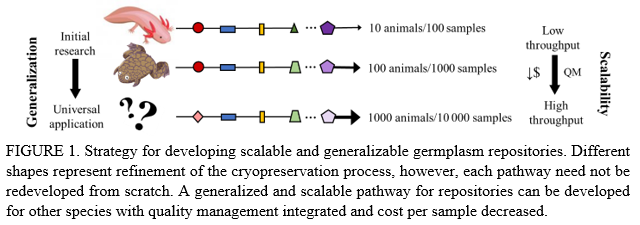SCALABLE AND GENERALIZED APPROACHES FOR STOCK-CENTER-BASED REPOSITORY CAPABILITIES
The axolotl, Ambystoma mexicanum, is a biomedical model used for research in tissue regeneration to better understand and improve treatment of spinal cord and limb injuries . The African clawed frog, Xenopus laevis, offers a useful platform to investigate treatments for other human diseases . Aquatic biomedical organisms such as these provide valuable resources for many branches of human health research, and as such have comprehensive national stock centers to maintain and distribute animals . P roduction of transgenic and mutant lines in these and other species has led to a rapidly expanding need for a cost-effective and efficient way to maintain the increasing number of lines. Storage of cryopreserved germplasm in repositories can provide a way to protect such lines and reduce the number of live animals held at each center . In collaboration with the Ambystoma Genetic Stock Center (University of Kentucky) and the National Xenopus Resource (Woods Hole Marine Biological Laboratory), we aim to develop a high-throughput cryopreservation pathway that is both scalable and generalizable (Figure 1), integrating processing and quality management to establish repository capabilities for these species. These would be integrated into a larger Aquatic Biomedical Repository Network developed in cooperation with the USDA National Animal Germplasm Program (and associated Animal-GRIN database) located in Ft. Collins, CO and the AGGRC. Based on existing processes for reproduction and cryopreservation in these centers, we will employ user-centered design approaches to develop repository programs that serve the needs of the centers and their associated research communities. A major design consideration is that the practices at any center will be in accordance with those of the other centers (to facilitate network activities), and that these processes can be applied generally across a broad spectrum of scale. Thus, this collaborative initiative will consider repository development in a multi-level approach that addresses far more than simple protocol development.
